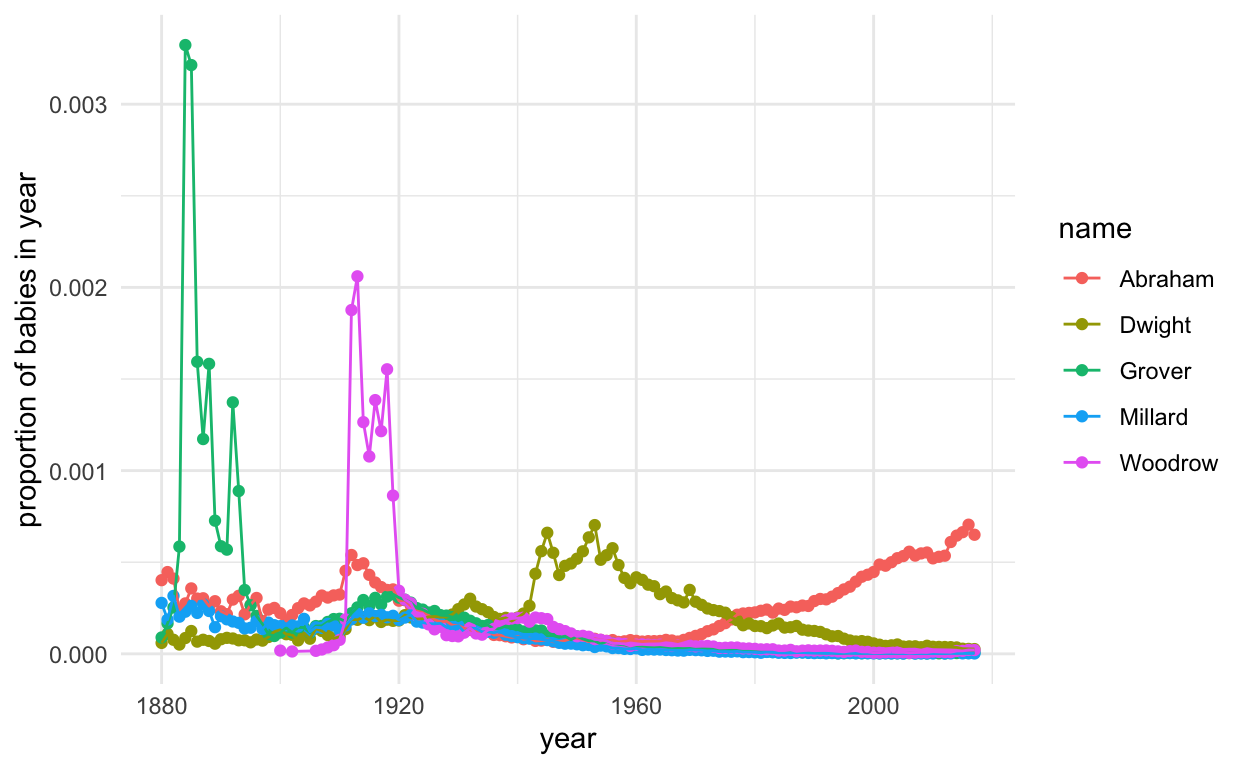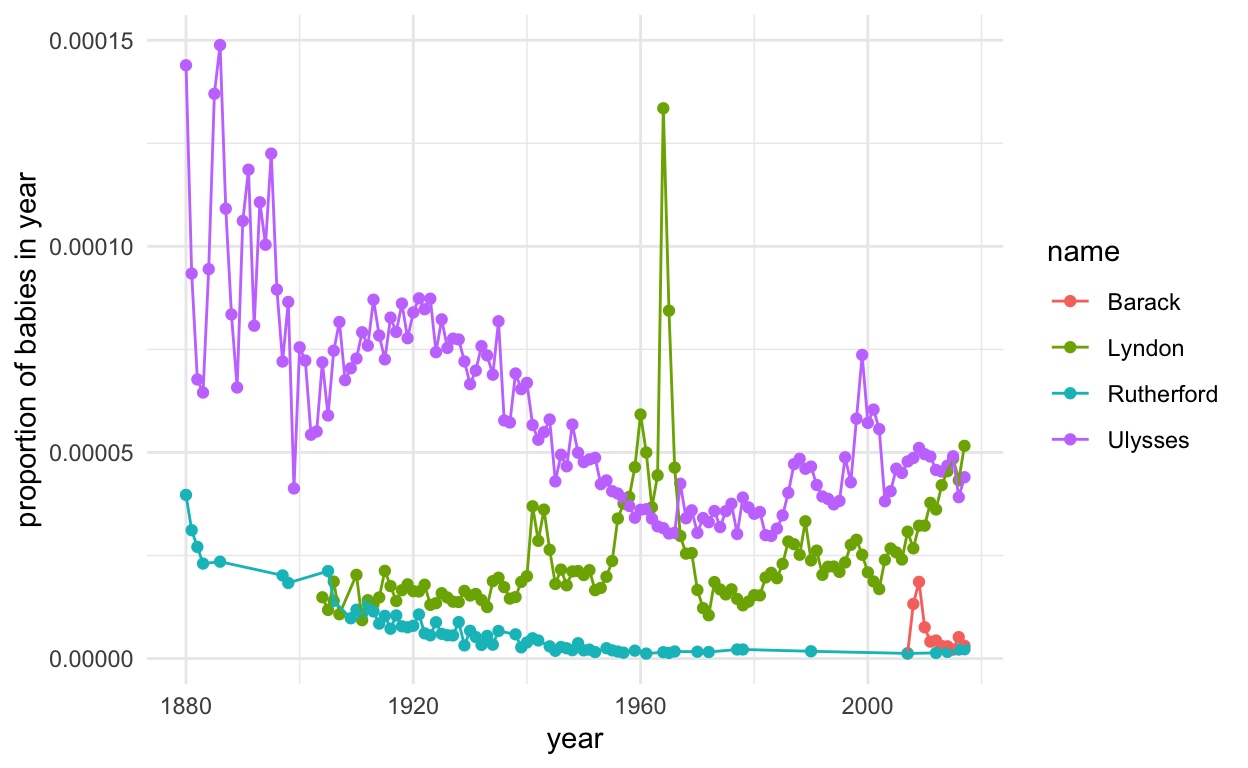We are hearing these names a lot, and it’s only going to continue (p.s. VOTE). But don’t these names seem a bit… ordinary to you?
How popular are these Democratic candidate names throughout history? The babynames dataset can help shed some light on this question. Let’s look at the proportion of babies with these particular names over time.
candidates <- c("Elizabeth", "Amy", "Joseph", "Peter", "Bernard", "Michael", "Thomas")
candidate_status <- c(T, F, T, F, T, T, F)
yearTotals <- babynames %>%
group_by(year) %>%
summarise(yearTotal = sum(n))
candidateData <- babynames %>%
filter(name %in% candidates) %>%
group_by(year, name) %>%
summarise(count = sum(n))
candidateData <- merge(candidateData, yearTotals, by.x = "year", by.y = "year")
candidateData$prop <- candidateData$count / candidateData$yearTotal
ggplot(candidateData, aes(year, prop, col = name, group = name)) +
geom_point() +
geom_line() +
theme_minimal() +
ylab("proportion of babies in year")

Fad names (with peaks): Amy, Thomas, Michael
More stable names: Bernard, Elizabeth, Joseph, Peter
For the sticklers, we can just look at the ones moving forward.
ggplot(subset(candidateData, name %in% candidates[candidate_status]), aes(year, prop, col = name, group = name)) +
geom_point() +
geom_line() +
theme_minimal() +
ylab("proportion of babies in year")

But this is just proportion of babies over time. What about the ranking of names? (Insert ranked choice voting joke here.)
test <- babynames %>%
group_by(year, name) %>%
summarise(count = sum(n))
allYears <- unique(test$year)
# this is gross, but bear with me
helper <- function(x) {
dat <- subset(test, year == x)
dat <- dat %>% arrange(desc(count))
dat$ranking <- 1:nrow(dat)
return(dat)
}
byYearRanking <- lapply(allYears, helper)
allRanked <- do.call("rbind", byYearRanking)
allRanked %>%
filter(name %in% candidates) %>%
ggplot(., aes(year, ranking, col = name, group = name)) +
geom_point() +
geom_line() +
theme_minimal()

Many of these names are ranked pretty high fairly consistently.
allRanked %>%
filter(name %in% candidates[candidate_status]) %>%
ggplot(., aes(year, ranking, col = name, group = name)) +
geom_point() +
geom_line() +
theme_minimal()

Alas, poor Bernard, let’s zoom in a bit.
allRanked %>%
filter(name %in% candidates) %>%
ggplot(., aes(year, ranking, col = name, group = name)) +
geom_point() +
geom_line() +
theme_minimal() +
ylim(c(0, 750))

It appears that these names often make the top 200 of baby names each year.
What are the average and best ranks across time?
allRanked %>%
filter(name %in% candidates) %>%
group_by(name) %>%
summarise(avgRank = mean(ranking), bestRank = min(ranking)) %>%
arrange(avgRank)
# A tibble: 7 x 3
name avgRank bestRank
<chr> <dbl> <int>
1 Joseph 15.9 7
2 Thomas 30.4 10
3 Elizabeth 30.9 8
4 Michael 60.3 1
5 Peter 152. 67
6 Amy 288. 9
7 Bernard 594. 107Joseph has the best average rank, but only Michael reached the top spot at one point in history.
How consistently were these names in the top 200, 100, or 50 spot over time?
allRanked %>%
filter(ranking <= 200) %>%
group_by(name) %>%
summarise(count = n()) %>%
arrange(desc(count)) %>%
filter(name %in% candidates)
# A tibble: 7 x 2
name count
<chr> <int>
1 Elizabeth 138
2 Joseph 138
3 Michael 138
4 Thomas 138
5 Peter 112
6 Amy 48
7 Bernard 32allRanked %>%
filter(ranking <= 100) %>%
group_by(name) %>%
summarise(count = n()) %>%
arrange(desc(count)) %>%
filter(name %in% candidates)
# A tibble: 6 x 2
name count
<chr> <int>
1 Elizabeth 138
2 Joseph 138
3 Thomas 138
4 Michael 89
5 Peter 43
6 Amy 28allRanked %>%
filter(ranking <= 50) %>%
group_by(name) %>%
summarise(count = n()) %>%
arrange(desc(count)) %>%
filter(name %in% candidates)
# A tibble: 5 x 2
name count
<chr> <int>
1 Joseph 138
2 Elizabeth 137
3 Thomas 120
4 Michael 80
5 Amy 19Out of 138 years of data, Joseph has always been in the top 50 of baby names. Elizabeth misses perfection by one year. Peter doesn’t crack the top 50 ceiling, but makes it into the top 100. Bernard manages to be in the top 200 for 32 years. It seems like these candidates are taking “name recognition” benefits a bit too far.
What does this mean for the presidential hopefuls? We love a good George, John, or James for president, but we’ve also had a Millard and Rutherford, so it’s anyone’s guess.
presidents <- c("George", "John", "Thomas", "James", "Andrew", "Martin", "William", "Zachary", "Millard", "Franklin", "Abraham", "Ulysses", "Rutherford", "Chester", "Grover", "Benjamin", "Theodore", "Woodrow", "Warren", "Calvin", "Herbert", "Harry", "Dwight", "Lyndon", "Richard", "Gerald", "Ronald", "Barack", "Donald")
presidentData <- babynames %>%
filter(name %in% presidents) %>%
group_by(year, name) %>%
summarise(count = sum(n))
presidentData <- merge(presidentData, yearTotals, by.x = "year", by.y = "year")
presidentData$prop <- presidentData$count / presidentData$yearTotal
presidentPop <- presidentData %>%
group_by(name) %>%
summarise(averageProp = mean(prop)) %>%
arrange(desc(averageProp))
presidentPop$id <- 1:nrow(presidentPop)
presidentData <- merge(presidentData, presidentPop, by.x = "name", by.y = "name")
ggplot(subset(presidentData, id %in% 1:5), aes(year, prop, col = name, group = name)) +
geom_point() +
geom_line() +
theme_minimal() +
ylab("proportion of babies in year")

ggplot(subset(presidentData, id %in% 6:10), aes(year, prop, col = name, group = name)) +
geom_point() +
geom_line() +
theme_minimal() +
ylab("proportion of babies in year")

ggplot(subset(presidentData, id %in% 11:15), aes(year, prop, col = name, group = name)) +
geom_point() +
geom_line() +
theme_minimal() +
ylab("proportion of babies in year")

ggplot(subset(presidentData, id %in% 16:20), aes(year, prop, col = name, group = name)) +
geom_point() +
geom_line() +
theme_minimal() +
ylab("proportion of babies in year")

ggplot(subset(presidentData, id %in% 21:25), aes(year, prop, col = name, group = name)) +
geom_point() +
geom_line() +
theme_minimal() +
ylab("proportion of babies in year")

ggplot(subset(presidentData, id %in% 26:30), aes(year, prop, col = name, group = name)) +
geom_point() +
geom_line() +
theme_minimal() +
ylab("proportion of babies in year")
